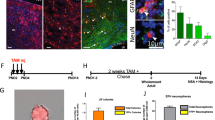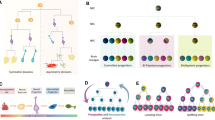Abstract
Understanding the fate commitment of neural stem cells is critical to identify the regulatory mechanisms in developing brains. Genetic lineage-tracing has provided a powerful strategy to unveil the heterogeneous nature of stem cells and their descendants. However, recent studies have reported controversial data regarding the heterogeneity of neural stem cells in the developing mouse neocortex, which prevents a decisive conclusion on this issue. Here, we review the progress that has been made using lineage-tracing analyses of the developing neocortex and discuss stem cell heterogeneity from the viewpoint of comparative and evolutionary biology.

Similar content being viewed by others
References
Kretzschmar K, Watt FM (2012) Lineage tracing. Cell 148:33–45
McConnell SK, Kaznowski CE (1991) Cell cycle dependence of laminar determination in developing neocortex. Science 254:282–285
Desai AR, McConnell SK (2000) Progressive restriction in fate potential by neural progenitors during cerebral cortical development. Development 127:2863–2872
Shen Q, Wang Y, Dimos JT, Fasano CA, Phoenix TN, Lemischka IR, Ivanova NB, Stifani S, Morrisey EE, Temple S (2006) The timing of cortical neurogenesis is encoded within lineages of individual progenitor cells. Nat Neurosci 9:743–751
Reid CB, Liang I, Walsh C (1995) Systematic widespread clonal organization in cerebral cortex. Neuron 15:299–310
Walsh C, Cepko CL (1988) Clonally related cortical cells show several migration patterns. Science 241:1342–1345
Kornack DR, Rakic P (1995) Radial and horizontal deployment of clonally related cells in the primate neocortex: relationship to distinct mitotic lineages. Neuron 15:311–321
Walsh C, Cepko CL (1992) Widespread dispersion of neuronal clones across functional regions of the cerebral cortex. Science 255:434–440
Franco SJ, Gil-Sanz C, Martinez-Garay I, Espinosa A, Harkins-Perry SR, Ramos C, Muller U (2012) Fate-restricted neural progenitors in the mammalian cerebral cortex. Science 337:746–749
Garcia-Moreno F, Molnar Z (2015) Subset of early radial glial progenitors that contribute to the development of callosal neurons is absent from avian brain. Proc Natl Acad Sci USA 112:E5058–5067
Gil-Sanz C, Espinosa A, Fregoso SP, Bluske KK, Cunningham CL, Martinez-Garay I, Zeng H, Franco SJ, Muller U (2015) Lineage tracing using Cux2-Cre and Cux2-CreERT2 mice. Neuron 86:1091–1099
Guo C, Eckler MJ, McKenna WL, McKinsey GL, Rubenstein JL, Chen B (2013) Fezf2 expression identifies a multipotent progenitor for neocortical projection neurons, astrocytes, and oligodendrocytes. Neuron 80:1167–1174
Eckler MJ, Nguyen TD, McKenna WL, Fastow BL, Guo C, Rubenstein JL, Chen B (2015) Cux2-positive radial glial cells generate diverse subtypes of neocortical projection neurons and macroglia. Neuron 86:1100–1108
Gao P, Postiglione MP, Krieger TG, Hernandez L, Wang C, Han Z, Streicher C, Papusheva E, Insolera R, Chugh K, Kodish O, Huang K, Simons BD, Luo L, Hippenmeyer S, Shi SH (2014) Deterministic progenitor behavior and unitary production of neurons in the neocortex. Cell 159:775–788
Nomura T, Takahashi M, Hara Y, Osumi N (2008) Patterns of neurogenesis and amplitude of Reelin expression are essential for making a mammalian-type cortex. PloS ONE 3:e1454
Nomura T, Gotoh H, Ono K (2013) Changes in the regulation of cortical neurogenesis contribute to encephalization during amniote brain evolution. Nat Commun 4:2206
Suzuki IK, Kawasaki T, Gojobori T, Hirata T (2012) The temporal sequence of the mammalian neocortical neurogenetic program drives mediolateral pattern in the chick pallium. Dev Cell 22:863–870
Dugas-Ford J, Rowell JJ, Ragsdale CW (2012) Cell-type homologies and the origins of the neocortex. Proc Natl Acad Sci USA 109:16974–16979
Nomura T, Izawa E-I (2017) Avian brains: insights from development, behaviors and evolution. Dev Growth Differ 59:244–257
Nomura T, Ohtaka-Maruyama C, Yamashita W, Wakamatsu Y, Murakami Y, Calegari F, Suzuki K, Gotoh H, Ono K (2016) The evolution of basal progenitors in the developing non-mammalian brain. Development 143:66–74
Martinez-Cerdeno V, Cunningham CL, Camacho J, Keiter JA, Ariza J, Lovern M, Noctor SC (2016) Evolutionary origin of Tbr2-expressing precursor cells and the subventricular zone in the developing cortex. J Comp Neurol 524:433–447
Puzzolo E, Mallamaci A (2010) Cortico-cerebral histogenesis in the opossum Monodelphis domestica: generation of a hexalaminar neocortex in the absence of a basal proliferative compartment. Neural Dev 5:8
Moreno N, Gonzalez A (2017) Pattern of neurogenesis and identification of neuronal progenitor subtypes during pallial development in Xenopus laevis. Front Neuroanat 11:24
Nomura T, Kawaguchi M, Ono K, Murakami Y (2013) Reptiles: a new model for brain evo-devo research. J Exp Zool B Mol Dev Evol 320:57–73
Yamashita T, Ono K, Ohuchi H, Yumoto A, Gotoh H, Tomonari S, Sakai K, Fujita H, Imamoto Y, Noji S, Nakamura K, Shichida Y (2014) Evolution of mammalian Opn5 as a specialized UV-absorbing pigment by a single amino acid mutation. J Biol Chem 289:3991–4000
Ventura RE, Goldman JE (2007) Dorsal radial glia generate olfactory bulb interneurons in the postnatal murine brain. J Neurosci 27:4297–4302
Merkle FT, Mirzadeh Z, Alvarez-Buylla A (2007) Mosaic organization of neural stem cells in the adult brain. Science 317:381–384
Fuentealba LC, Rompani SB, Parraguez JI, Obernier K, Romero R, Cepko CL, Alvarez-Buylla A (2015) Embryonic origin of postnatal neural stem cells. Cell 161:1644–1655
Furutachi S, Miya H, Watanabe T, Kawai H, Yamasaki N, Harada Y, Imayoshi I, Nelson M, Nakayama KI, Hirabayashi Y, Gotoh Y (2015) Slowly dividing neural progenitors are an embryonic origin of adult neural stem cells. Nat Neurosci 18:657–665
Loulier K, Barry R, Mahou P, Le Franc Y, Supatto W, Matho KS, Ieng S, Fouquet S, Dupin E, Benosman R, Chédotal A, Beaurepaire E, Morin X, Livet J (2014) Multiplex cell and lineage tracking with combinatorial labels. Neuron 81(3):505–520
Garcia-Moreno F, Vasistha NA, Begbie J, Molnar Z (2014) CLoNe is a new method to target single progenitors and study their progeny in mouse and chick. Development 141:1589–1598
McKenna A, Findlay GM, Gagnon JA, Horwitz MS, Schier AF, Shendure J (2016) Whole-organism lineage tracing by combinatorial and cumulative genome editing. Science 353:aaf7907
Lewitus E, Kelava I, Kalinka AT, Tomancak P, Huttner WB (2014) An adaptive threshold in mammalian neocortical evolution. PLoS Biol 12:e1002000
Otani T, Marchetto MC, Gage FH, Simons BD, Livesey FJ (2016) 2D and 3D stem cell models of primate cortical development identify species-specific differences in progenitor behavior contributing to brain size. Cell Stem Cell 18:467–480
Acknowledgements
We thank Drs. Ei-ichi Izawa, Hideyo Ohuchi and Yoshinori Shichida for providing brains of jungle crow and common marmoset. This review article is based on several research projects that were supported by the Grant-in-Aids for Scientific Research Innovative Areas No. 26118510 (to T.N.): “The Evolutionary Origin and Neural Basis of Empathetic Systems”, No. 26118510 (to T.N.): “Integrative understanding of biological phenomena with temperature as a key theme” No. 16H01394, and PRESTO, the Japan Science Technology Agency (JST)(to T.N.).
Author information
Authors and Affiliations
Corresponding author
Rights and permissions
About this article
Cite this article
Nomura, T., Gotoh, H. & Ono, K. The Future Vocation of Neural Stem Cells: Lineage Commitment in Brain Development and Evolution. Neurochem Res 43, 162–165 (2018). https://doi.org/10.1007/s11064-017-2380-z
Received:
Revised:
Accepted:
Published:
Issue Date:
DOI: https://doi.org/10.1007/s11064-017-2380-z




